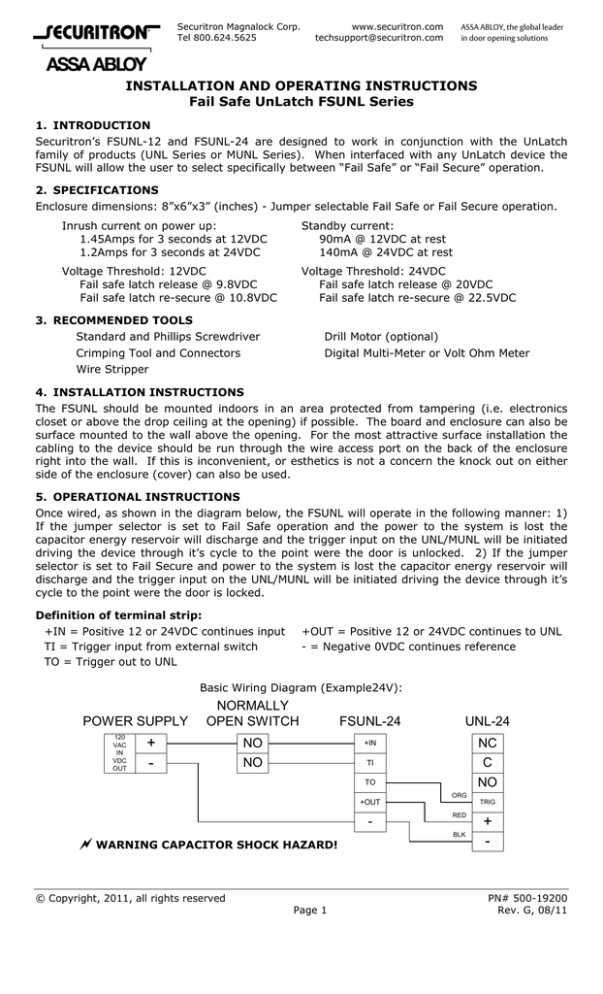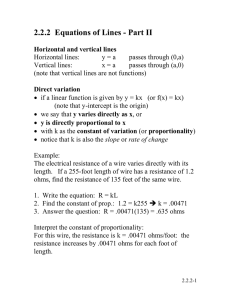
Securitron Magnalock Corp.
Tel 800.624.5625
www.securitron.com
techsupport@securitron.com
ASSA ABLOY, the global leader
in door opening solutions
INSTALLATION AND OPERATING INSTRUCTIONS
Fail Safe UnLatch FSUNL Series
1. INTRODUCTION
Securitron’s FSUNL-12 and FSUNL-24 are designed to work in conjunction with the UnLatch
family of products (UNL Series or MUNL Series). When interfaced with any UnLatch device the
FSUNL will allow the user to select specifically between “Fail Safe” or “Fail Secure” operation.
2. SPECIFICATIONS
Enclosure dimensions: 8”x6”x3” (inches) - Jumper selectable Fail Safe or Fail Secure operation.
Inrush current on power up:
1.45Amps for 3 seconds at 12VDC
1.2Amps for 3 seconds at 24VDC
Standby current:
90mA @ 12VDC at rest
140mA @ 24VDC at rest
Voltage Threshold: 12VDC
Fail safe latch release @ 9.8VDC
Fail safe latch re-secure @ 10.8VDC
Voltage Threshold: 24VDC
Fail safe latch release @ 20VDC
Fail safe latch re-secure @ 22.5VDC
3. RECOMMENDED TOOLS
Standard and Phillips Screwdriver
Crimping Tool and Connectors
Wire Stripper
Drill Motor (optional)
Digital Multi-Meter or Volt Ohm Meter
4. INSTALLATION INSTRUCTIONS
The FSUNL should be mounted indoors in an area protected from tampering (i.e. electronics
closet or above the drop ceiling at the opening) if possible. The board and enclosure can also be
surface mounted to the wall above the opening. For the most attractive surface installation the
cabling to the device should be run through the wire access port on the back of the enclosure
right into the wall. If this is inconvenient, or esthetics is not a concern the knock out on either
side of the enclosure (cover) can also be used.
5. OPERATIONAL INSTRUCTIONS
Once wired, as shown in the diagram below, the FSUNL will operate in the following manner: 1)
If the jumper selector is set to Fail Safe operation and the power to the system is lost the
capacitor energy reservoir will discharge and the trigger input on the UNL/MUNL will be initiated
driving the device through it’s cycle to the point were the door is unlocked. 2) If the jumper
selector is set to Fail Secure and power to the system is lost the capacitor energy reservoir will
discharge and the trigger input on the UNL/MUNL will be initiated driving the device through it’s
cycle to the point were the door is locked.
Definition of terminal strip:
+IN = Positive 12 or 24VDC continues input
TI = Trigger input from external switch
TO = Trigger out to UNL
+OUT = Positive 12 or 24VDC continues to UNL
- = Negative 0VDC continues reference
Basic Wiring Diagram (Example24V):
POWER SUPPLY
120
VAC
IN
VDC
OUT
NORMALLY
OPEN SWITCH
+
-
NO
NO
FSUNL-24
UNL-24
+IN
NC
C
TI
NO
TO
ORG
+OUT
-
WARNING CAPACITOR SHOCK HAZARD!
© Copyright, 2011, all rights reserved
Page 1
TRIG
RED
BLK
+
-
PN# 500-19200
Rev. G, 08/11
5.1. WIRE GAUGE SIZING
If the power supply is at a distance from the device, voltage will be lost (dropped) in the
connecting wires so that the unit will not receive full voltage. The following chart shows the
minimum wire gauge that will hold voltage drop to an acceptable 5% for different device to
power supply distances. Proper use of the chart assumes a dedicated pair of wires to power
each unit (no common negative). Note that a device operating on 24 volts is a much better
choice for long wire runs as it has 4 times the resistance of a 12 volt installation. Also note
that the correct calculation of wire sizing is a very important issue as the installer is
responsible to insure that adequate voltage is supplied to any load. In multiple unit
installations, the calculation can become quite complex so refer to Section 7 Appendix A for a
more complete discussion.
Distance
80 FT
200 FT
400 FT
Gauge 12V
20 GA
17 GA
14 GA
Gauge 24V
24 GA
22 GA
20 GA
Distance
800 FT
1500 FT
3000 FT
Gauge 12V
10 GA
8 GA
N/A
Gauge 24V
16 GA
14 GA
12 GA
CALCULATING WIRE GAUGE SIZING - The general practice of wire sizing in a DC circuit is to
avoid causing voltage drops in connecting wires that reduce the voltage available to operate the
device. As the FSUNL is a very low power device, it can be operated long distances from its
power source. For any job that includes long wire runs, the installer must be able to calculate
the correct gauge of wire to avoid excessive voltage drops.
This is done by taking the current draw of the lock and multiplying by the resistance of the wire I
x R = Voltage drop (i.e. 0.100A x 10.1 Ohms = 1.01 Volts dropped across the wire). For all
intents and purposes it can be said that a 5% drop in voltage is acceptable so if this were a 24
Volt system (24 Volts x .05 = 1.2 Volts) a 1.01 Volt drop would be within tolerance.
To calculate the wire resistance, you need to know the distance from the power supply to the
FSUNL and the gauge (thickness) of the wire. The following chart shows wire resistance per
1000 ft (305 meters):
To calculate the wire resistance, you need to know the distance from the power supply to the
FSUNL and the gauge (thickness) of the wire. The following chart shows wire resistance per
1000 ft (305 meters):
Wire Gauge
8 Gauge
10 Gauge
12 Gauge
14 Gauge
Resistance/1,000 ft
.6 Ohms
1.0 Ohms
1.6 Ohms
2.5 Ohms
Wire Gauge
16 Gauge
18 Gauge
20 Gauge
22 Gauge
Resistance/1,000 ft
4.1 Ohms
6.4 Ohms
10.1 Ohms
16.0 Ohms
6. MAGNACARE LIFETIME REPLACEMENT WARRANTY
For warranty information visit: www.securitron.com/en/site/securitron/About/MagnaCare-Warranty/
Page 2
PN# 500-19200
Rev. G, 08/11





